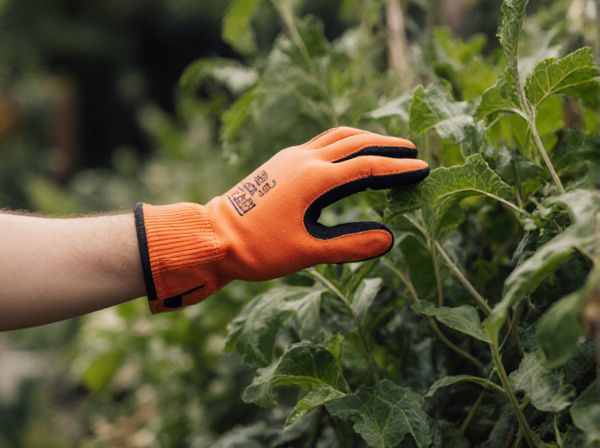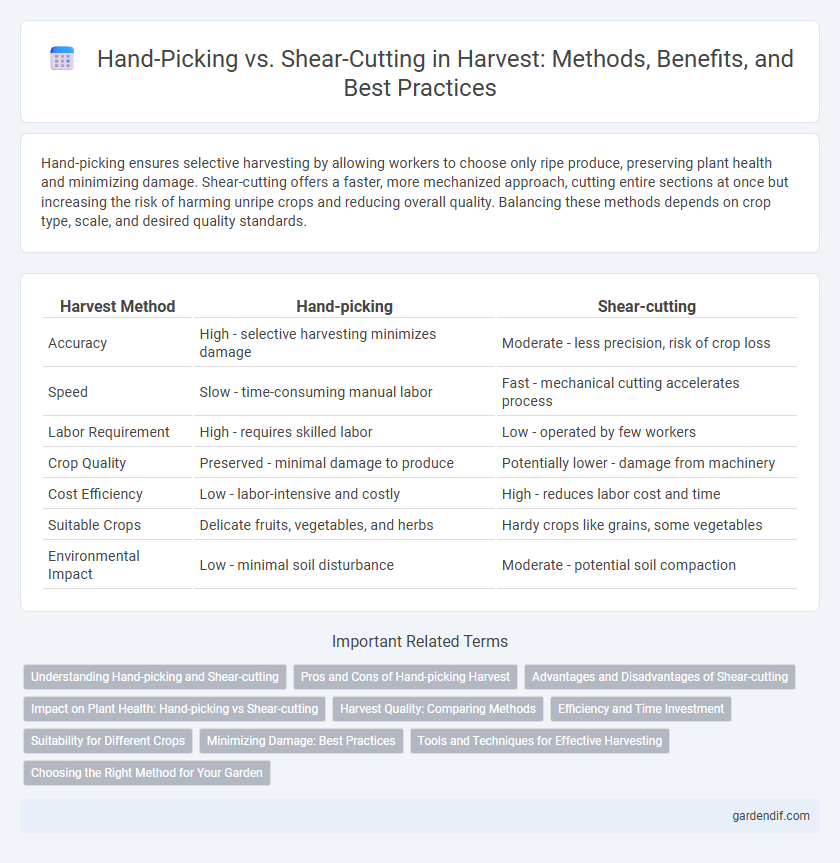
Hand-picking vs Shear-cutting Illustration
Hand-picking ensures selective harvesting by allowing workers to choose only ripe produce, preserving plant health and minimizing damage. Shear-cutting offers a faster, more mechanized approach, cutting entire sections at once but increasing the risk of harming unripe crops and reducing overall quality. Balancing these methods depends on crop type, scale, and desired quality standards.
Table of Comparison
| Harvest Method | Hand-picking | Shear-cutting |
|---|---|---|
| Accuracy | High - selective harvesting minimizes damage | Moderate - less precision, risk of crop loss |
| Speed | Slow - time-consuming manual labor | Fast - mechanical cutting accelerates process |
| Labor Requirement | High - requires skilled labor | Low - operated by few workers |
| Crop Quality | Preserved - minimal damage to produce | Potentially lower - damage from machinery |
| Cost Efficiency | Low - labor-intensive and costly | High - reduces labor cost and time |
| Suitable Crops | Delicate fruits, vegetables, and herbs | Hardy crops like grains, some vegetables |
| Environmental Impact | Low - minimal soil disturbance | Moderate - potential soil compaction |
Understanding Hand-picking and Shear-cutting
Hand-picking involves manually selecting individual crops or fruit to ensure only ripe produce is harvested, preserving quality and reducing damage. Shear-cutting utilizes mechanical or manual blades to cut entire sections of plants quickly, increasing efficiency but potentially including unripe or less desirable parts. Understanding these methods helps optimize harvest decisions based on crop type, quality requirements, and labor resources.
Pros and Cons of Hand-picking Harvest
Hand-picking harvest allows for selective picking, preserving crop quality by avoiding damage and ensuring only ripe produce is collected, which is crucial for delicate fruits like berries and grapes. This method, however, is labor-intensive, time-consuming, and often more costly compared to mechanized shear-cutting, limiting scalability for large farms. Hand-picking reduces waste and contamination risks, but reliance on manual labor can lead to variability in yield and potential delays during peak harvest times.
Advantages and Disadvantages of Shear-cutting
Shear-cutting during harvest offers the advantage of faster processing and reduced labor costs compared to hand-picking, making it ideal for large-scale operations. However, shear-cutting can lead to increased crop damage, reduced product quality, and a higher risk of contamination since entire plant sections are cut indiscriminately. This method may also result in more significant post-harvest losses due to bruising and less selective harvesting.
Impact on Plant Health: Hand-picking vs Shear-cutting
Hand-picking preserves plant health by minimizing damage to stems and leaves, which supports continuous growth and reduces the risk of disease. Shear-cutting, while faster, can cause more extensive tissue injury, increasing vulnerability to infections and slowing plant recovery. Choosing hand-picking enhances sustainable harvesting by maintaining plant integrity and promoting long-term productivity.
Harvest Quality: Comparing Methods
Hand-picking preserves the integrity of delicate crops by minimizing physical damage and reducing contamination, resulting in higher harvest quality and better shelf life. Shear-cutting speeds up the harvesting process but can cause bruising and increased moisture loss, which may compromise the freshness and market value of produce. Selecting the appropriate method depends on crop type and desired quality standards, with hand-picking favored for premium and perishable items.
Efficiency and Time Investment
Hand-picking allows for precise selection of ripe produce, minimizing waste and ensuring higher quality, though it demands more time and labor intensity. Shear-cutting offers faster harvest rates and reduced physical strain, enhancing efficiency in large-scale operations but may result in less selectivity and potential crop damage. Balancing these methods depends on crop type, desired quality, and scale of production to optimize overall harvest efficiency and time investment.
Suitability for Different Crops
Hand-picking ensures careful selection of delicate crops like berries and grapes, preserving fruit integrity and minimizing damage. Shear-cutting suits sturdier crops such as wheat and hay, enabling rapid harvesting but with potential for increased crop bruising. Choosing the method depends on crop fragility, yield scale, and post-harvest handling requirements.
Minimizing Damage: Best Practices
Hand-picking allows for selective harvesting, reducing bruising and preserving the integrity of delicate fruits and vegetables. Shear-cutting, when performed with sharp, clean tools and proper technique, minimizes plant tissue damage and reduces the risk of infection. Employing gentle handling and immediate post-harvest care further minimizes damage and maintains crop quality.
Tools and Techniques for Effective Harvesting
Hand-picking employs tools such as baskets and gloves to carefully select ripe crops, preserving plant integrity and ensuring minimal damage during harvest. Shear-cutting uses specialized garden shears or mechanical cutters to swiftly cut stems, optimizing efficiency for large-scale harvesting while maintaining crop quality. Choosing the appropriate tool depends on crop type, harvest scale, and desired preservation of plant structures to maximize yield and reduce post-harvest losses.
Choosing the Right Method for Your Garden
Hand-picking allows for selective harvesting, preserving plant integrity and reducing damage, ideal for delicate fruits and herbs. Shear-cutting offers efficiency and speed, suitable for bulk crops like leafy greens and flowers, ensuring cleaner cuts and faster regrowth. Choosing the right method depends on crop type, garden size, and desired harvest quality to optimize yield and plant health.
Hand-picking vs Shear-cutting Infographic

 gardendif.com
gardendif.com